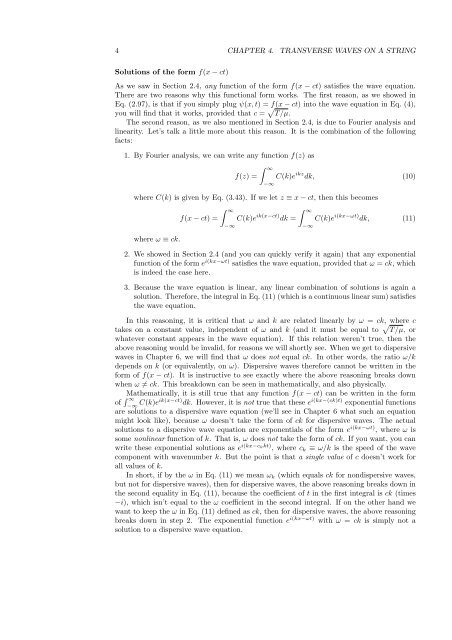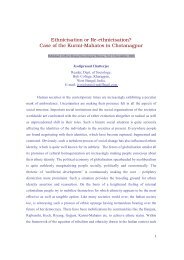Transverse waves on a string - People.fas.harvard.edu
Transverse waves on a string - People.fas.harvard.edu
Transverse waves on a string - People.fas.harvard.edu
You also want an ePaper? Increase the reach of your titles
YUMPU automatically turns print PDFs into web optimized ePapers that Google loves.
4 CHAPTER 4. TRANSVERSE WAVES ON A STRING<br />
Soluti<strong>on</strong>s of the form f(x − ct)<br />
As we saw in Secti<strong>on</strong> 2.4, any functi<strong>on</strong> of the form f(x − ct) satisfies the wave equati<strong>on</strong>.<br />
There are two reas<strong>on</strong>s why this functi<strong>on</strong>al form works. The first reas<strong>on</strong>, as we showed in<br />
Eq. (2.97), is that if you simply plug ψ(x, t) = f(x − ct) into the wave equati<strong>on</strong> in Eq. (4),<br />
you will find that it works, provided that c = T/µ.<br />
The sec<strong>on</strong>d reas<strong>on</strong>, as we also menti<strong>on</strong>ed in Secti<strong>on</strong> 2.4, is due to Fourier analysis and<br />
linearity. Let’s talk a little more about this reas<strong>on</strong>. It is the combinati<strong>on</strong> of the following<br />
facts:<br />
1. By Fourier analysis, we can write any functi<strong>on</strong> f(z) as<br />
∞<br />
f(z) = C(k)e ikz dk, (10)<br />
−∞<br />
where C(k) is given by Eq. (3.43). If we let z ≡ x − ct, then this becomes<br />
∞<br />
f(x − ct) = C(k)e ik(x−ct) ∞<br />
dk = C(k)e i(kx−ωt) dk, (11)<br />
where ω ≡ ck.<br />
−∞<br />
2. We showed in Secti<strong>on</strong> 2.4 (and you can quickly verify it again) that any exp<strong>on</strong>ential<br />
functi<strong>on</strong> of the form e i(kx−ωt) satisfies the wave equati<strong>on</strong>, provided that ω = ck, which<br />
is indeed the case here.<br />
3. Because the wave equati<strong>on</strong> is linear, any linear combinati<strong>on</strong> of soluti<strong>on</strong>s is again a<br />
soluti<strong>on</strong>. Therefore, the integral in Eq. (11) (which is a c<strong>on</strong>tinuous linear sum) satisfies<br />
the wave equati<strong>on</strong>.<br />
In this reas<strong>on</strong>ing, it is critical that ω and k are related linearly by ω = ck, where c<br />
takes <strong>on</strong> a c<strong>on</strong>stant value, independent of ω and k (and it must be equal to T/µ, or<br />
whatever c<strong>on</strong>stant appears in the wave equati<strong>on</strong>). If this relati<strong>on</strong> weren’t true, then the<br />
above reas<strong>on</strong>ing would be invalid, for reas<strong>on</strong>s we will shortly see. When we get to dispersive<br />
<str<strong>on</strong>g>waves</str<strong>on</strong>g> in Chapter 6, we will find that ω does not equal ck. In other words, the ratio ω/k<br />
depends <strong>on</strong> k (or equivalently, <strong>on</strong> ω). Dispersive <str<strong>on</strong>g>waves</str<strong>on</strong>g> therefore cannot be written in the<br />
form of f(x − ct). It is instructive to see exactly where the above reas<strong>on</strong>ing breaks down<br />
when ω = ck. This breakdown can be seen in mathematically, and also physically.<br />
Mathematically, it is still true that any functi<strong>on</strong> f(x − ct) can be written in the form<br />
of ∞<br />
−∞ C(k)eik(x−ct) dk. However, it is not true that these e i(kx−(ck)t) exp<strong>on</strong>ential functi<strong>on</strong>s<br />
are soluti<strong>on</strong>s to a dispersive wave equati<strong>on</strong> (we’ll see in Chapter 6 what such an equati<strong>on</strong><br />
might look like), because ω doesn’t take the form of ck for dispersive <str<strong>on</strong>g>waves</str<strong>on</strong>g>. The actual<br />
soluti<strong>on</strong>s to a dispersive wave equati<strong>on</strong> are exp<strong>on</strong>entials of the form e i(kx−ωt) , where ω is<br />
some n<strong>on</strong>linear functi<strong>on</strong> of k. That is, ω does not take the form of ck. If you want, you can<br />
write these exp<strong>on</strong>ential soluti<strong>on</strong>s as e i(kx−ckkt) , where ck ≡ ω/k is the speed of the wave<br />
comp<strong>on</strong>ent with wavenumber k. But the point is that a single value of c doesn’t work for<br />
all values of k.<br />
In short, if by the ω in Eq. (11) we mean ωk (which equals ck for n<strong>on</strong>dispersive <str<strong>on</strong>g>waves</str<strong>on</strong>g>,<br />
but not for dispersive <str<strong>on</strong>g>waves</str<strong>on</strong>g>), then for dispersive <str<strong>on</strong>g>waves</str<strong>on</strong>g>, the above reas<strong>on</strong>ing breaks down in<br />
the sec<strong>on</strong>d equality in Eq. (11), because the coefficient of t in the first integral is ck (times<br />
−i), which isn’t equal to the ω coefficient in the sec<strong>on</strong>d integral. If <strong>on</strong> the other hand we<br />
want to keep the ω in Eq. (11) defined as ck, then for dispersive <str<strong>on</strong>g>waves</str<strong>on</strong>g>, the above reas<strong>on</strong>ing<br />
breaks down in step 2. The exp<strong>on</strong>ential functi<strong>on</strong> e i(kx−ωt) with ω = ck is simply not a<br />
soluti<strong>on</strong> to a dispersive wave equati<strong>on</strong>.<br />
−∞

















